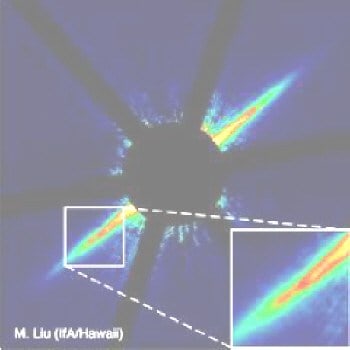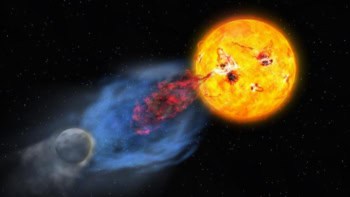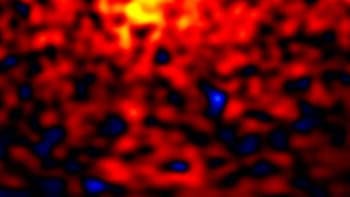An astronomer in the US has taken the sharpest ever image of the dust disk around a nearby star and seen "clumps" of material that could be evidence for new planets forming. Michael Liu of the University of Hawaii used the Keck II telescope in Hawaii to observe a young star called AU Microscopii, and says that the results could help shed light on the formation of planets (M Liu 2004 Sciencexpress 1102929).

Astronomers believe that planets form from the dust and debris that surround young stars. As this material rotates around the star, gravitational forces cause the dust to clump together into planets.
AU Microscopii weighs just half a solar mass and is only the fourth star ever — and the closest to Earth — to have its dust disk imaged. Since 85% of all stars in the Milky Way are low-mass stars like AU Microscopii, observations of its disk may provide important clues about how the majority of planetary systems evolve.
Earlier this year Liu and colleagues discovered AU Microscopii’s dust disk using a 2.2-metre telescope. The images they obtained showed that the disk extended out to about 210 astronomical units from the star, where 1 astronomical unit (AU) is the average distance between the Earth and the Sun.
Now, using the 10-metre Keck II telescope, Liu has obtained new images of the disk that are 30 times sharper. The images have an angular resolution of 0.04 arcseconds, which means that features as small as 0.4 AUs can be distinguished.
Liu found that the star’s disk was uneven and contained clumps lying between 25 to 40 AUs from the star. These distances correspond to the size of Neptune’s and Pluto’s orbits in our solar system. The clumps are made of dust, which may be shaped by the gravitational influence of newly formed planets, he says.
AU Microscopii is about 12 million years old, which is the age at which planets are thought to form around stars. In contrast, the Sun is 4.6 billion years old.



